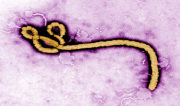Oxford Researchers Map Potential Ebola Infections in African Animals
The most devastating outbreak of the Ebola virus to date continues to take the lives of more people in West Africa, leaving the rest of the world to figure out not only how to prevent future outbreaks but also what may have caused this one.

The most devastating outbreak of the Ebola virus to date continues to take the lives of more people in West Africa, leaving the rest of the world to figure out not only how to prevent future outbreaks but also what may have caused this one.
A team of researchers from Oxford University have begun to look at the animal population on the continent as a possible cause for current and past outbreaks as a way of controlling the problem going forward. Their work includes a map showing the countries and regions in Africa where Ebola-infected animals are most likely to be found.
There have been more than 2,000 confirmed cases of the virus in this current outbreak. However, the authors noted there have only been 30 confirmed cases of people contracting the virus from animals. They looked at data on human and animal infections dating back to 1976, studying factors such as vegetation, elevation, temperature, and bat populations as part of their research.
“Whilst rare as a human disease, Ebola virus is thought to be present in many animal populations, especially bats, which can carry the virus without it being lethal to them,” the statement from the school noted.
“Although the disease may be found in animals across a wide area, outbreaks are still very rare; very few animals in this region have detectable infections and it is extremely rare for humans to catch the disease from them,” noted David Pigott, a lead author who works in the school’s department of zoology.
Saying the maps represent a “reservoir” of where the Ebola virus is likely to be found in the animal populations, fellow author Nick Golding added, “This does not mean that transmission to humans is inevitable in these areas; only that all the environmental and epidemiological conditions suitable for an outbreak occur there.”
Looking at the data, Golding continued, “Gaining a better understanding of where people are coming into contact with these infected animals, for example through hunting, and how to protect those at risk from Ebola is crucial to preventing future outbreaks.”
Most of the cases in the current outbreak have been in West Africa, with more being reported from Guinea and the Democratic Republic of Congo. While not geographically close, the authors note the similarities between the countries could make animal infection a contributing factor.
When it comes to the Ebola virus and animal infection many people may conjure the image of a monkey, but the authors said bats are more likely to be carriers of the virus. They said in their statement that three species of fruit bats have so far been found to carry the virus.
“Unfortunately, we have a very poor understanding of exactly where these bat species are found and which populations are infected,” noted Golding. “We believe that bats in areas that are likely to be at risk should be tested for Ebola virus, to better understand the threat to local people.”
The study was funded in part by grants from the Wellcome Trust and the Bill and Melinda Gates Foundation.